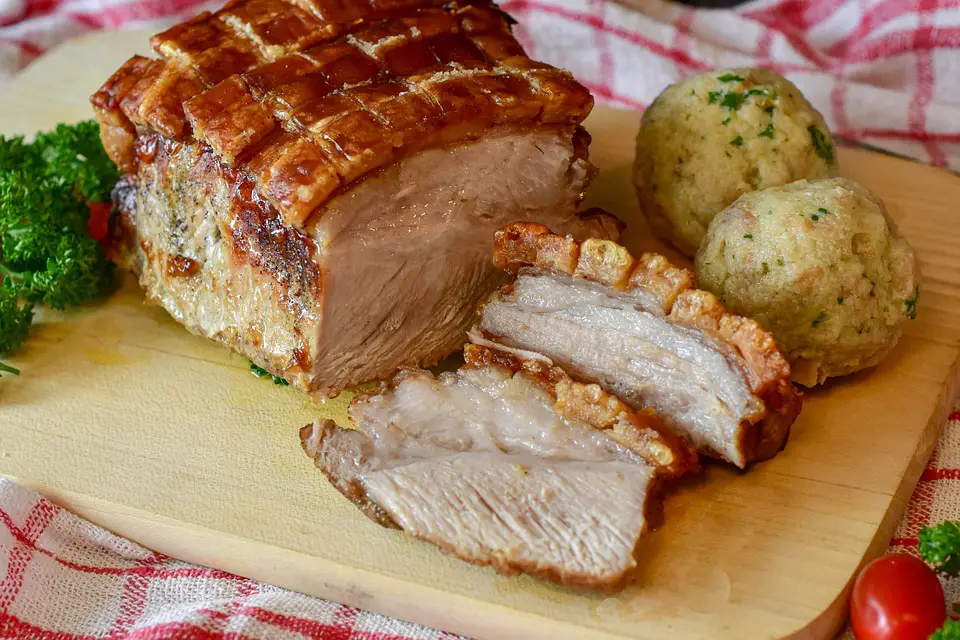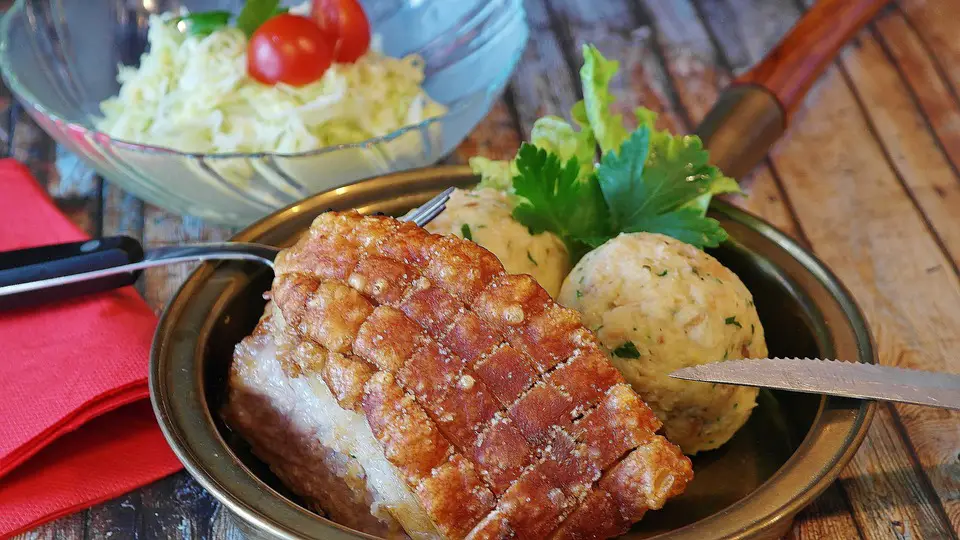Even on the busiest of weeknights, roast pork remains one of the simplest dishes to cook. You can extend leftovers to last the entire week. For a simple midweek dinner with roasted vegetables or anything else, reheat your roast pork. Some of the best methods for reheating roast pork are listed here.
Before attempting to reheat frozen leftovers, give them time to thaw. Whether you have a large amount of leftover pork roast or a small amount, reheating it in the oven can be a great way to enjoy it again. The process involves low temperatures to lock in the flavors and juices.

What is Pork Roast?
The region of the pig between the shoulder and the start of the leg is where the pork loin roast is produced. It can be purchased either bone-in or deboned; loin roasts with a bone are typically juicier and more flavorful, but you’ll need to slice around it when serving. Pork loin roast without bones can be coiled and knotted before cooking.
Although they are different, pork loin roast and tenderloin are occasionally mistaken. The tenderloin is a smaller, longer cut of pork that typically weighs less than a pound, whereas a pork loin roast is typically sold in pieces weighing 2-4 pounds.
Pork loin roasts are wonderful when brined or spice-rubbed and grilled over indirect heat. Because they have the propensity to fall apart and become a little rough when cooked using moist heat, pork loin roasts shouldn’t be braised or stewed.
How to Reheat a Pork Roast in the Oven?
The oven is one of the best places to reheat roast pork. Using this technique, you can preserve your pork’s juicy, crispy flavor. This process requires little effort and is quick. All you need is a pan or oven tray, some leftover roast pork, and perhaps some oil or spray.
Carry out these actions;
- Your oven should be preheated to at least 325 degrees Fahrenheit first.
- Put your meat on a pan or oven tray large enough to hold your roast pork.
- Put your pan or dish inside the preheated oven.
- Before removing your meat to check its internal temperature, give it about 20 minutes to cook.
- If your pork hasn’t warmed up properly, just put it back in the oven. Make sure to check your pork every five minutes. After some time, your pork should be prepared for serving.
- Another method for reheating roast pork in the oven is to put it in an oven-safe dish and add 1/8 cup of water, broth, or stock to the pan. Reheat your oven to 300 degrees Fahrenheit, then cover your roast pan with foil to complete the heating process. By doing this, you can avoid overcooking the roast pork while maintaining its moisture and juiciness. Place the pan containing the leftover pork inside the oven and allow the steam and convection to cook the pork.
- This additional method works well for reheating roast pork without drying it out.
Is Pork Still Good After Seven Days?
Although pork can be frozen to keep it fresh for longer, it only has a shelf life of one to two days after its “sell by” date. The sell-by date, the cooking technique, and the storage conditions all affect how long pork will stay fresh.
If the package for your hog meat has a sell-by date printed, it should continue to be good for another day or two after that time. If the packaging doesn’t list an expiration date, you can assume that whole chunks of pork will keep for up to 5 days; ground pork will keep for 1–2 days and cooked, and leftover pork will keep for 3–4 days.
What are the Benefits of Pork Roast for Health?
Pork has a lot of good protein and various essential vitamins and minerals. Pork cooked correctly can be a fantastic addition to a balanced meal.
Preservation of Muscular Mass
Pork is a fantastic source of high-quality protein, much like most animal products. Maintaining muscle mass as you age is crucial for your health.
Muscle mass normally declines as you age without exercise and a healthy diet, which is unfavorable and linked to several age-related health issues.
Muscle wasting can result in sarcopenia, a disorder with extremely low levels of muscle mass and a worsened quality of life in extreme cases. The majority of cases of sarcopenia affect older adults.
Your chance of developing sarcopenia may increase if you don’t get enough high-quality protein as you age.
Pork is a great approach to maintaining enough dietary intake of high-quality protein that may assist sustain muscle mass, as are other protein-rich meals.
Improved Capacity for Exercising
Consuming meat helps you stay fit and preserve your muscular mass, but it may also enhance your physical performance.
Pork has many high-quality proteins and other nutritious nutrients that are good for your muscles. These consist of beta-alanine, creatine, and taurine.
Your body needs the amino acid beta-alanine to make carnosine, which is necessary for proper muscular function.
Increased muscle carnosine levels have been associated with less fatigue and enhanced physical performance.
Carnosine muscle levels gradually decline by eating a vegetarian or vegan diet, which is low in beta-alanine.
In contrast, increased dietary beta-alanine intake, including supplements, raises muscle carnosine levels.
Reference: Effects of Eating Fresh Lean Pork on Cardiometabolic Health Parameters
High-protein meat-based diets are frequently recommended for weight loss, ostensibly by boosting satiety and calorie burning. Pork is a good source of protein, but little is known about how eating pork affects the metabolism. In a 6-month parallel intervention trial, this pilot study sought to determine whether regular eating of fresh, lean pork may reduce cardiovascular risk factors and improve body composition. 164 obese adults (mean BMI 32) were given the option to retain their regular diet or add up to 1 kg of pork per week by substituting other meals (control).
What are the Risks of Consuming Pork Roast?
Pork could have risks due to its high sodium and saturated fat content.
Pork is a good source of several essential vitamins and nutrients, but it can also be high in sodium and saturated fats, which are to be avoided as part of a healthy diet.
Pork should be as lean and less processed as possible if you’re following a low-salt diet due to heart health concerns or to avoid saturated fats.
It would be best to ingest sulfates or sulfites in very small amounts because they are chemical preservatives in some cured pig products like bacon. Instead, go for salt-cured or uncured choices.
Remember that the amount of fat in the pork will vary depending on how you prepare it. Choose grilling, roasting, baking, or broiling over frying. Bacon and other fatty pig products should be avoided. Select leaner, less processed, and higher protein types instead.
Possibly Carry Parasites
Pigs that are consumed raw or undercooked risk contracting parasites. An intestinal parasite known as pork tapeworm is called Taenia solium. Although it seldom does so, it can occasionally result in cysticercosis, which can cause epilepsy.
Trichinosis, an infection with parasitic roundworms called Trichinella, can also be brought on by consuming raw or undercooked pork. Although the signs and symptoms of trichinosis are typically modest, they can worsen and can be fatal, especially in older adults.
Pork should always be cooked properly to prevent parasite infestation. Before serving, use a meat thermometer to check that the meat has reached a temperature that will effectively destroy bacteria and parasites.
What is the Correct Method of Defrosting the Pork?
It’s never a good idea to thaw meat on the counter since bacteria multiply quickly at ambient temperature. Instead, let the pork thaw in the refrigerator for at least 24 hours. Placing the pork in the refrigerator about two days beforehand is the best approach to guarantee that the meat thaws completely before you reheat it. The thawed pork will be secured in the refrigerator for three to four days.
Throw away the meat if it makes you feel the least bit sick due to an unpleasant smell, slimy texture, or any other issue.
How to Spot Bad Cooked Pork?
Bacteria from two different species can live on a pig. The first two elements might be considered when buying ground pork at the grocery store—a protracted episode of vomiting and nausea. It will only get sourer and smell worse if you try to cook pork.
Pork releases an unpleasant smell similar to ammonia when something goes wrong. In the end, it is preferable to discard it. If you’re unsure, it’s preferable to throw anything away. By observing the meat’s appearance, you could be of assistance. When done well, pork can be delicious and a great source of protein.
It must be moist, but it shouldn’t be slimy. Pork has a foul smell that is stronger and more overt as it begins to spoil. It’s time to discard the pork if it smells strange. It will only get sourer and smell worse if you try to cook pork.
Cooked leftovers should be consumed within three to four days, according to the USDA. There are two different types of bacteria: spoilage bacteria, which cause food to decay and generate unpleasant smells, odors, and textures, and pathogenic bacteria, which cause foodborne illness.
Effective food control is essential because the latter type is something you should be concerned about but won’t frequently be able to identify. Blood in the stools and cramping are other side effects. When you first open the container, sniff the fresh pork to see if it has an unpleasant or sour smell.
Fresh pork should be grayish-pink or rose-to-red instead of decaying pork, which should be greenish-brown or dark grey. It should not be used for cooking if it has a foul scent. However, sour pork has an overpowering, ammonia-like odor.
Can Fresh Pork be Frozen?
Fresh pork can be frozen without risk if you aren’t yet ready to eat it. Make sure the pork is stored in a freezer bag that is tightly packed to prevent freezer burn or to dry out from the cold air.
You may prevent having UFOs (Unidentified Frozen Objects!) in your freezer by clearly labeling foods and the date they were frozen. Meat can be frozen at any time before its use-by date. Observe any guidelines provided on the packaging for how long items should be kept frozen. If there are no instructions, we advise eating the food within three to six months of freezing it to preserve the product’s quality.
Conclusion
Whether you’re reheating leftovers or cooking a new roast, there are several ways to do it. The first is by using an oven. This method is ideal for roasts and other large cuts of meat. However, the microwave can also cook pork, though it’s important to watch the food’s progress. Large cuts of meat, such as a pork roast, must be cooked slowly so that the heat can penetrate the outer layers. If the center of the cut is overcooked before the rest of the roast, the meat will end up tough.
The internal temperature of the meat should be 165 degrees Fahrenheit. The USDA Food Safety and Inspection Service recommend this. If you have an oven thermometer, you can check the temperature of the meat at regular intervals. Once the pork has reached the appropriate temperature, it should be steamed. Place the pork in a pan with neutral-flavoured oil and a lid.
